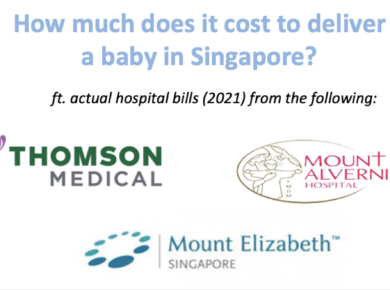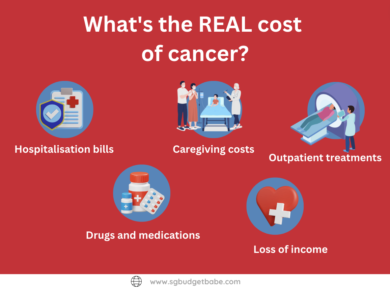In my previous article, I wrote about how the most comprehensive maternity insurance plan you can possibly get in Singapore (which covers prenatal OB/GYN expenses, delivery costs and even NICU bills) do in fact exist, but if you were too late to purchase them (meaning you’ve only started to look at insurance now that you are pregnant), there are still other options available by the local insurers.
While the coverage is less extensive, it can still be helpful. For instance, within my social circle alone, I had several friends who were diagnosed with pre-eclampsia during their pregnancy, but managed to defer part of the costs by claiming from their maternity insurance.
Since no one knows what will happen during pregnancy, many people are undecided when it comes to whether they ought to buy such a plan. Some insurance agents do not recommend it, whereas others say it is an absolute must-have. In this article, I’ll run through the reasons why people tend to purchase maternity insurance, as well as its limitations, so you can make an informed decision for yourself.
Also, quite a few of you requested for an update from my previous comparison done in 2018 when I was pregnant with my firstborn, so here’s a comparison of how the plans stack up in 2021. Several new insurers have joined in, and new plans have been added!
Can I do without maternity insurance?
Firstly, you should take note that MediShield Life already covers hospitalisation bills for 24 pregnancy complications – including pre-eclampsia and gestational diabetes (see the full list here, which was revamped in 2019).
Hence, if you’re on a tight budget and cannot afford additional insurance, then choosing to give birth in a public hospital will be your best defence / bet against potentially life-changing expensive bills. But if all goes well with your pregnancy, then you can still give birth in a private hospital (read about why I chose to go private here) without getting into debt.
However, what MediShield Life does NOT protect you for is:
- NICU costs due to premature birth
- phototherapy costs due to severe neonatal jaundice (be it inpatient stays or outpatient i.e. rental of the machine)
Thus, you’ll have to evaluate what these risks mean to you, and whether you’re willing to spend $300 – $600 on standalone maternity insurance premiums in exchange to get those covered. Note that bundled plans (like those offered by AIA or AXA) often see most mothers paying $2,000+ due to the multiple policies bought.
Why do people buy maternity insurance?
The strongest case for buying maternity insurance is because it can help guarantee insurance coverage for your newborn. This means that you can get for your baby an insurance plan from the same insurer (be it a life plan with/without critical illness benefit, or even an ILP) without any medical check-up needed.
If your baby is not born completely healthy, this helps to guarantee their insurability for life – because otherwise you’ll have issues getting them covered after.
Considering that the vast majority of babies in Singapore are generally born healthy, this is where you’ll have to gauge your own risk appetite to stake on such odds.
The other benefits that comes with getting maternity insurance are often:
- hospitalisation cash benefit for each day the mother is hospitalised due to pregnancy complications (this came in handy for my friend when she was recently warded in her 34th week of pregnancy and had to stay there for an entire month, up until she gave birth)
- hospitalisation coverage for congenital conditions (as of June 2021, OCBC and Great Eastern covers for the least number i.e. 18 congenital conditions vs. the 23 – 26 conditions covered by other insurers)
- hospitalisation cash benefit for each day the baby is hospitalised due to congenital illnesses
- inpatient or outpatient phototherapy benefit due to severe neonatal jaundice (currently only offered by Aviva, Income and Manulife). Jaundice is fairly common among newborns, and even Nate had it…except that we managed to get his bilirubin levels down in time to avoid having to rent the phototherapy machine. Several of my friends, on the other hand, had to lug the machine home for treatment while a few had to have their babies extend their stay in the hospital for it.


As you can see, there are clearly benefits to buying maternity insurance. The question is whether you feel it is necessary, given that the majority of births in Singapore are generally free from complications, and most people do not end up claiming from their maternity insurance even if they had purchased it.
If you’ve decided to buy this additional coverage for yourself, how do you now choose which one to get?
Which is the best maternity insurance?
Even when it comes to deciding which is the best maternity insurance for you, opinions can vary.
Those are more kiasu may prefer AXA’s Empowered Mum policy, as it covers for more pregnancy complications and congenital illnesses. But naturally, that comes at a much higher cost which some couples may not be able to stomach, especially as you need to bundle it with either an ILP or life plan.
So here’s my consolidated research (updated as of 2021) on maternity insurance plans across the 8 insurers, covering both standalone and bundled plans. You can also view my Excel spreadsheet here and decide which is best for you.


Note that you’ll have to prepare to pay higher premiums if you go for any of the first 5 plans, as they come bundled with other plans. The actual cost will then depend on what plan you bundled it with – Aviva’s could potentially be the lowest in this sense since they have a wider flexibility of what you can bundle it with, which I appreciate.
Of course, there’s a good chance that you might not end up having to make any claims from your maternity insurance plan in the end. That’s a good thing – because you were paying the premiums for protection against the “what ifs” anyway.
What is NOT covered under maternity insurance?
Unfortunately, even having maternity insurance may not be sufficient if your pregnancy has complications. Here are some common scenarios that I’ve seen happen to my friends…and who are unable to claim from their insurance:
Early admission for suspected pre-term labour
Spotting (after 32 weeks) is pretty common among some mothers in their third trimester, and while reasons vary, many believe it is due to overwork or exhaustion. However, these are not covered under the list of pregnancy complications in most maternity insurance policies!
Hospitalisation expenses
What some people do not realise is that if you are warded because of your pregnancy, you will not be able to claim the hospitalisation bill from your MediShield Life or Integrated Shield Plan…unless you were admitted due to any of the stated serious pregnancy complications (e.g. pre-eclampsia, placental abruption, uterine rupture, etc).
If you have maternity insurance, you will only be able to get a daily payout of either $100 a day or 1 – 2% of your sum assured (i.e. $100 – $200). While any cash payout helps, it’ll still barely be enough to cover your bill.
NICU expenses
In the event that your baby is born early and/or has complications requiring a stay in the neonatal ICU, no maternity insurance will be enough to cover you. While there are no clear indications of how much NICU costs are per day (due to too many variables, including the level of care that your baby needs), if you deliver in a private hospital A Ward, that could even go beyond $5,000 per day.
NUH’s NICU charges start from $150 (C Class) to $695 (A1 class), according to their website.
I’ll be using my estimated bill size of $250,000 instead (which was what KKH quoted me for the lowest class ward – click to see my quotation here before subsidies), but even then you can see that’s a huge sum! No local maternity insurance will cover that for you. Click here to find out what kind of insurance you can buy to protect yourself against these huge financial risks instead.
So should I buy maternity insurance?
Ultimately, you have to decide whether you feel the cost is worthwhile. There are no right or wrong answers. The only thing that is for sure is, if your pregnancy ends up having complications that you could have claimed for under maternity insurance, then you’ll definitely be wishing you had bought some. But all this is just on hindsight.
If you wish to give your child the gift of guaranteed insurability, then you can treat the $1k – $2k expenses on a bundled maternity insurance plan as such.
Otherwise, a more affordable method would be to go for a standalone plan, where $300 – $400 should be sufficient to get you a $5,000 coverage in the event of any major complications because just in case.
Of course, once your baby has been born, don’t forget to get them insured against what you deem important – in our case, we got a private hospitalisation plan, personal accident policy and critical illness coverage for Nate. There are also other types that you may want to consider here for your child.
If you’re a first-time parent looking for more support and resources on your journey, you may also find these articles helpful:
- Pregnant? Here’s how much you may need to prepare
- The Minimalist’s Baby Essentials Checklist
- Save money with these Baby Must-Haves from Taobao!
- Hospital comparison: KKH vs. Thomson Medical vs. Mount Alvernia
- Actual hospital bill for pregnancy delivery: KKH vs. Parkway East vs. Thomson Medical vs. Mount Alvernia
- What to pack in your hospital bag
- 9 Financial Must-Dos when you’re having a baby
- Should I store or donate my baby’s cord blood?
- My review of Cordlife vs. Stemcord vs. Cryoviva (updated 2021)
- Should I hire a confinement nanny?
- How to DIY your own confinement
- How to save money in your baby’s first year
- How much we spent in our baby’s first year
You can also check out more parenting resources on my Instagram page here.
With love,
Budget Babe





